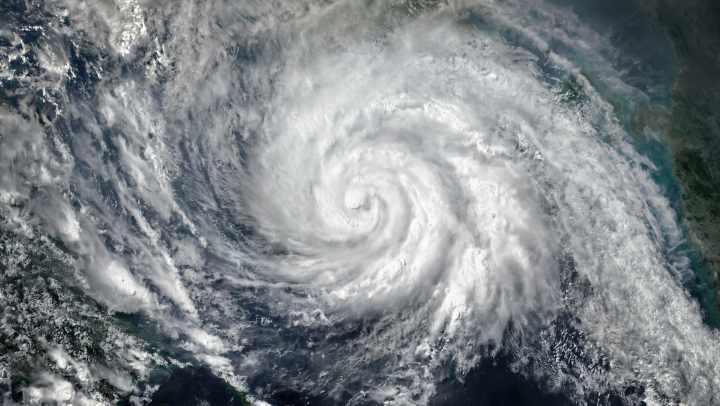This article offers hurricane preparedness tips for older adults and their caregivers while exploring the many benefits of a senior living community - before, during, and after a storm strikes.
Relieving Hurricane Season Stress: Guidance for Seniors & Caregivers
The summer season brings with it warmer weather, longer days, fun in the sun – and the arrival of hurricane season! The Atlantic Hurricane Season runs from June 1 through November 30 and for residents living in coastal areas, it’s crucial to have a plan in place to protect yourself and senior loved ones from hurricane impact.
Before scheduling your summer plans, know what precautions to take and get prepared with the following emergency-preparedness tips to help relieve hurricane season stress.
Make preparations
Create a plan in advance to outline your own emergency response. Using the guidance below, and local recommendations, reflect on priority needs and action items with loved ones. Make a list of steps to follow, supplies to gather, and support needed from others to ensure the right preparations are in place.
Critical Documents
Critical documents are vital to prepare in advance of any storm and can be collected with minimal or no additional cost to your monthly budget. Think of these documents as the “paperwork” you file in a safe place, such as:
-
Personal identification (driver’s license, birth certificate, passport, etc.)
-
Medication and immunization records
-
Social security cards
-
Family records (marriage license, etc.)
-
Health insurance cards
-
Wills, advanced directives, power of attorney documentation
Once your documents have been pulled from safe-keeping, secure original copies in a weatherproof tote (zip-top freezer storage bags work, too) and ensure additional copies are available for backup purposes. Cash, checkbooks, family contact info, and details for health, home, and other insurance policies should be easily accessible.
For practical assistance with this task, the “Vital Document Checklist” offered by AARP’s Operation Hurricane Prepare is a printable tool designed to help seniors and their loved ones complete this collection process.
Health & Safety Essentials
Health and safety essentials include medical care and personal supplies needed to maintain an individual’s independence and address health and safety issues. These can include:
-
Mobility aids or assistive devices (walkers, wheelchairs, oxygen tanks, etc.)
-
Eyeglasses/contact lenses and vision care items
-
Hearing aids (and batteries)
-
Personal hygiene and continence care items
-
Towel and facecloth
-
Face masks to filter dust and bacteria
-
First-aid kit
-
All medications and supplies, including those only needed for emergencies
-
Daily prescriptions
-
Over-the-counter medications
-
An updated personal medication record
-
An insulated bag with ice packs for short-term temperature control when refrigeration of medication is not available
-
Plan to fill all prescriptions in advance to avoid running out of any needed medication. If an evacuation is necessary, you don’t want the added stress of knowing medication is not readily available.
Storm Supplies
A hurricane preparedness kit should consist of critical documents, health and safety essentials, and daily necessities. The supplies list below offers a good place to start when collecting storm supplies for yourself or a senior loved one.
Daily Necessities
Daily necessities refer to the items you will need most frequently should you lose power or need to prepare for evacuation and seek shelter elsewhere. Set aside enough supplies to last at least three days for each person. Any items currently stored at home should be inspected for expiration dates and safe use and assembled in a secure, weatherproof tote. This storage kit should keep supplies dry and easy to transport when needed.
-
Water (one gallon per person, per day)
-
Non-perishable food (canned food, can opener, dry goods, protein drinks)
-
Matches or lighters in a waterproof container
-
Battery-powered flashlight and lantern
-
Battery-powered radio
-
Extra batteries, phone charger and cable, and solar chargers
-
Blankets or sleeping bags
-
Extra clothing & rain gear/poncho
-
Garbage bags, zip-top bags (for keeping things dry)
-
Soap, wipes, and hand sanitizer
-
Toilet paper and paper towels
-
Mess kits for eating, disposable plates/utensils
-
Reusable water bottles
-
Whistle for alerting rescuers
-
Waterproof smartphone bag
-
Pet supplies
For a more extensive list or additional information to consider when creating a storm supplies kit, visit www.ready.gov.
Secure your home.
Think ahead about protecting your home - both indoors and out – before a severe storm strikes, especially when living alone. Plan to share contact and location information with neighbors or close friends in case you evacuate and need updates from your hometown or neighborhood. Below are a few steps to help secure your home:
-
Repair roof/window leaks or faulty features that can cause greater damage
-
Close and lock all windows and doors and cover with shutters or plywood if preparing for high winds
-
Secure outdoor furniture, potted plants, trash cans, flags, and other fixtures
-
Shut off the main water valve and main electrical fuse or breaker box
-
Move fragile or valuable objects away from windows and wrap them in plastic wrap or garbage bags
-
Fill sinks and bathtubs with water to use for bathing, washing clothes, or flushing the toilet
-
Make sure your vehicle has a full tank of gas
-
Have extra propone available for your grill and be sure it is situated in a safe area (Never use any propane grill indoors!)
-
Have plastic sheeting, tarps, duct tape, or sandbags available
Consider your evacuation plan.
Planning in advance can relieve last-minute stress that comes with an evacuation order. Consider how and where you would evacuate and what items you would take. Keep your critical documents, health and safety essentials, and daily necessities securely stored in a dry, waterproof tote which can easily travel with you.
Have cash, car keys, phone numbers, shelter information, and maps for navigating your route, which are especially important if online map functions are not accessible due to lost cell service. Google Maps’ offline feature can be downloaded in advance or try an app, such as Navmii which can provide travel routes even when traffic and road closure information is not available.
Looking to Avoid the Stress of Storm Preparedness?
Preparing for a hurricane or any significant storm can be time-consuming, costly, and stressful for seniors and caregivers. Even the possibility of having to evacuate can create great anxiety, emotional distress, and confusion, especially for older adults who live alone or manage more complex healthcare needs.
Fortunately, senior living communities offer a wide range of safety measures and benefits to support older adults (and caregivers) before, during, and after a severe storm or emergency.
-
24/7 staffing and monitoring to ensure resident needs are met
-
Access to community supplies and resources
-
Collaborative emergency preparedness measures are initiated by community staff, which means responsibility doesn’t fall solely on the senior and/or their caregiver
-
Timely, direct, and consistent communication of vital information with residents and families throughout the storm response
-
Access to supplemental generator power for select functions, such as refrigeration and medical needs
-
Emergency lighting and fire prevention measures
-
Resident safety checks multiple times a day
-
An approved evacuation plan that provides oversight, staffing, resources, and safe transportation to alternative sites of care if residents’ safety is compromised or there is an extreme threat to the community
-
Management of the storm recovery response (negotiations with insurance companies, securing bids for repairs, procuring contractors, restoring power, replenishing supplies, etc.)
Another reassuring benefit of community living is the priority status offered to residents who are part of a senior living residence. Senior communities can receive support more quickly and efficiently during an emergency response, such as the restoration of power and other crucial services.
Additionally, many senior living communities offer a short-term stay option which allows individuals to test the lifestyle without a long-term commitment. This option can provide protection, resources, accessibility, and irreplaceable peace of mind for older adults living in hurricane-prone areas.
If an especially active hurricane season is on the horizon, or you are preparing yourself or a loved one for the season’s unpredictable outcomes, connect with a Stoney Brook senior living expert today. Learn more about the peace of mind experienced by senior living residents and families when relying on a Stoney Brook team.

